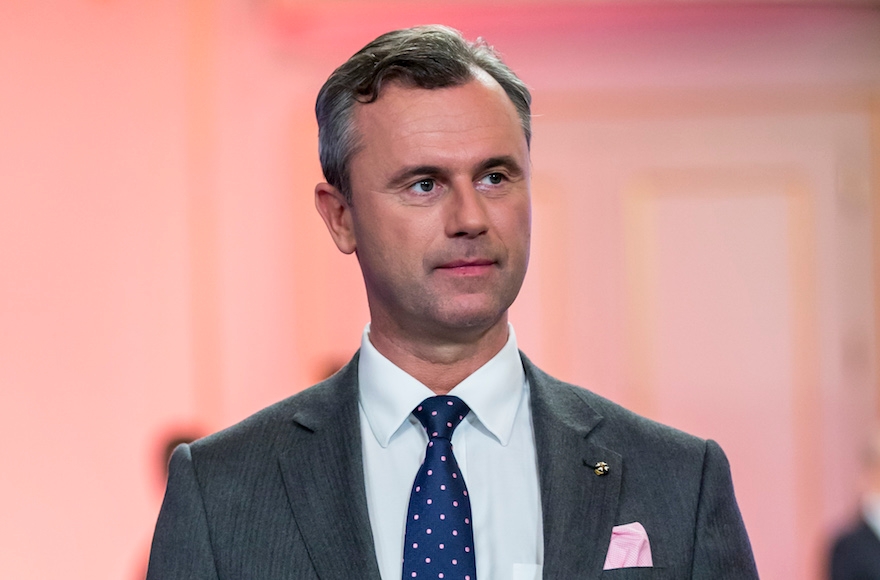(JTA) — Despite admitting to taking Jews to the gas chambers at Majdanek, Erna Wallisch lived as a free women in Vienna until she died at the ripe age of 86.
An Austrian former Nazi guard at two concentration camps, Wallisch died in 2008 after evading three attempts to prosecute her in Austria for crimes against humanity. In their final review of her actions, Austrian prosecutors said they decided to let her off the hook because she played only a “passive” role in facilitating genocide.
Wallisch, who allegedly beat some of her prisoners, is not an isolated case in Austria, where no one has been convicted for Nazi war crimes in at least 35 years. The SS commander of the Vilnius ghetto, Franz Murer, was acquitted after a weeklong trial in 1963, as was the architect of Auschwitz, Walter Dejaco, in 1973.
To prominent historians of the Third Reich, these cases exemplify Austrian society’s failure to confront its Nazi past — a failure they say is key to understanding why Austria is poised on Sunday to become the first European country to elect as its president a far-right politician from a party that was founded by a former SS officer.
“There is no question that Austria has done very little de-Nazification relative to Germany, which is the obvious object for comparison,” said Efraim Zuroff, the Nazi hunter and Israel director for the Simon Wiesenthal Center. “And that’s a big part of why the far right is far more popular in Austria than it is in Germany.”
The popularity of the Austrian far right was on display in May when 49.7 percent of voters in the country’s presidential elections opted for Norbert Hofer of the Freedom Party, an anti-Islam movement with a history of anti-Semitism. Its critics have accused the party of fascism since its establishment in 1956 by Anton Reinthaller, a former Nazi functionary and SS officer.
The Freedom Party lost the presidency – a largely ceremonial post in Austria — by a hair’s breadth to Alexander van der Bellen, a left-leaning environmentalist. But due to irregularities, a new election was called for Dec. 4. Polls are generally too close to call, but some predict a slight advantage for Hofer.
To be sure, the Freedom Party has joined other far-right movements in Europe in their efforts of recent years to move into the mainstream, shed their Nazi image and leave behind the anti-Semitic rhetoric of some of their former leaders.
Last year, the Freedom Party kicked out former lawmaker Susanne Winter for complimenting on Facebook a user who wrote: “The Zionist money-Jews worldwide are the problem.” That user, Winter said, “took the word[s] out of my mouth.” And in 2012, party chairman Heinz-Christian Strache apologized for posting on Facebook a caricature depicting an obese, hook-nosed banker wearing Star of David-shaped cuff links.
To some, these incidents indicate a persistent problem. They are part of the reason that, despite the support of some Jews in Austria for the Freedom Party, the country’s Jewish leaders have shunned the movement completely.
But the current situation is still notably different to the open embrace of Nazism by the Freedom Party’s previous leader, the late Joerg Haider, who called concentration camps “punishment facilities” and praised SS veterans as “decent people of good character” deserving of “every honor and recognition.”
The Freedom Party’s rise under Strache is part of a wave of support for far-right populists across Europe fueled by economic stagnation and social issues, including jihadism and sectarianism in established Muslim communities, coupled with the arrival in Europe of some 1.5 million additional Muslim immigrants since 2014.
In France, where the final round of the presidential election is scheduled to take place in May, polls are predicting a record 25 percent for the National Front party under Marine Le Pen. In the Netherlands, the anti-Islam politician Geert Wilders, who was convicted recently of incitement to hatred against Moroccans, has leapfrogged the center-right ruling party in polls ahead of the March general election.
But Austria, the birthplace of Adolf Hitler and the only country fully incorporated into the Nazi Third Reich during its reign of terror, is not just another European country because of its society’s complicity in the murder of Jews.
And whereas Germany, the other perpetrator nation, undertook massive educational and judicial efforts to delegitimize ultranationalism, Austria has taken no comparable actions. To Zuroff, the difference is evident in the popularity of the far right in those countries.
Germany’s far-right party, Alternative for Germany, is milder in its rhetoric than the Freedom Party, and enjoys only about 13 percent of the vote, according to numerous polls.
The dramatic difference in popularity between the far right in Germany and its Austrian counterpart reflects the different attitudes to Nazism in the postwar years, according to Stephan Templ, a Jewish-Austrian historian and an expert on the plunder of Jewish property in his country.
“For decades Austria perceived itself as Nazi Germany’s first victim,” he said.
Despite the wealth of evidence of Austrian society’s complicity in the Holocaust and other World War II atrocities, the victim narrative began to crack only in the 1990s, said Tina Walzer, a historian of Vienna and Templ’s partner.
Meanwhile in Western and Eastern Germany, de-Nazification committees screened public officials and removed tens of thousands of former Nazis from positions of influence. Tolerance education prepared millions of Germans for life in a multicultural society.
Austria did have its moments of soul searching, especially after the 1988 discovery that then-President Kurt Waldheim had concealed his service as an intelligence officer in Nazi Germany’s army in Yugoslavia and Greece. That army murdered civilians and sent tens of thousands of Greek Jews to the Auschwitz death camp.
“There was a generational clash, with the young wanting change,” Templ said. “But obviously this movement was not strong enough to prevent what we are seeing.”






